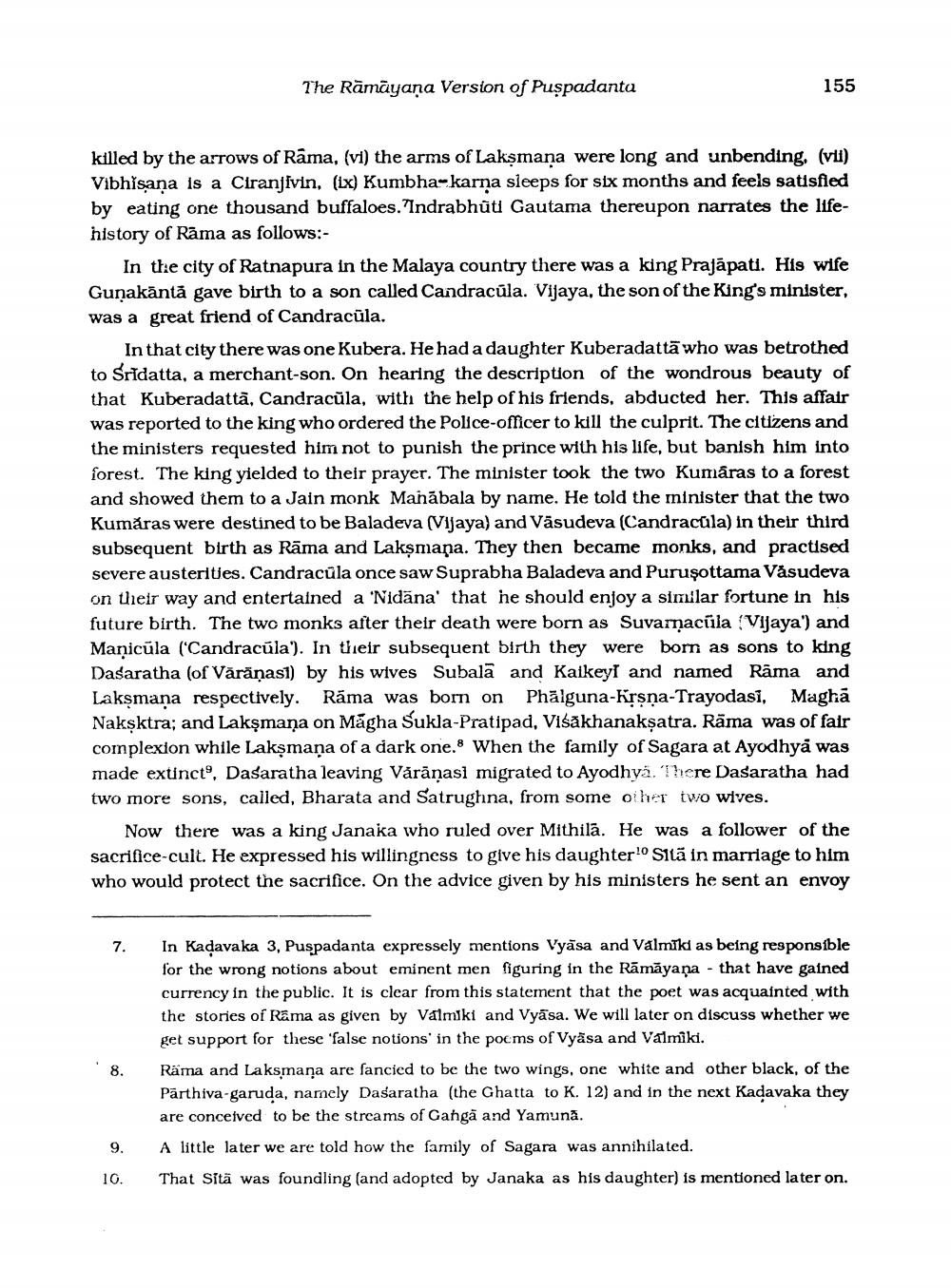________________
The Rāmāyaṇa Version of Puşpadanta
155
killed by the arrows of Rāma, (vi) the arms of Laksmana were long and unbending, (vii) Vibhisana is a Ciranjivin, (lx) Kumbha-karna sleeps for six months and feels satisfied by eating one thousand buffaloes. Indrabhūti Gautama thereupon narrates the lifehistory of Rāma as follows:
In the city of Ratnapura in the Malaya country there was a king Prajāpati. His wife Gunakāntă gave birth to a son called Candracula. Vijaya, the son of the King's minister, was a great friend of Candracula.
In that city there was one Kubera. He had a daughter Kuberadattā who was betrothed to Sridatta, a merchant-son. On hearing the description of the wondrous beauty of that Kuberadatta, Candracula, with the help of his friends, abducted her. This affair was reported to the king who ordered the Police-officer to kill the culprit. The citizens and the ministers requested him not to punish the prince with his life, but banish him into forest. The king yielded to their prayer. The minister took the two Kumāras to a forest and showed them to a Jain monk Manābala by name. He told the minister that the two Kumăras were destined to be Baladeva (Vijaya) and Vasudeva (Candracula) in their third subsequent birth as Rāma and Laksmana. They then became monks, and practised severe austerities. Candracũla once saw Suprabha Baladeva and Puruşottama Vasudeva on their way and entertained a 'Nidāna' that he should enjoy a similar fortune in his future birth. The two monks after their death were born as Suvarnacūla Vijaya') and Manicula (Candracula'). In their subsequent birth they were born as sons to king Dasaratha (of Vārāṇasi) by his wives Subala and Kaikeyi and named Rama and Laksmana respectively. Ráma was born on Phālguna-Krsna-Trayodasi, Maghā Nakşktra; and Lakşmaņa on Māgha Sukla-Pratipad, Višākhanakșatra. Rāma was of fair complexion while Lakşmaņa of a dark one. When the family of Sagara at Ayodhya was made extinct, Dasaratha leaving Vårānasi migrated to Ayodhyä. There Dasaratha had two more sons, called, Bharata and Satrughna, from some other two wives.
Now there was a king Janaka who ruled over Mithilā. He was a follower of the sacrifice-cult. He expressed his willingness to give his daughter! Sitä in marriage to him who would protect the sacrifice. On the advice given by his ministers he sent an envoy
7.
8.
In Kadavaka 3, Puspadanta expressely mentions Vyāsa and Valmīki as being responsible for the wrong notions about eminent men figuring in the Rāmāyana - that have gained currency in the public. It is clear from this statement that the poet was acquainted with the stories of Rama as given by Valmiki and Vyāsa. We will later on discuss whether we get support for these 'false notions in the poems of Vyäsa and Valmiki. Räma and Laksmana are fancied to be the two wings, one white and other black, of the Parthiva-garuda, namely Dasaratha (the Ghatta to K. 12) and in the next Kadavaka they are conceived to be the streams of Ganga and Yamunā. A little later we are told how the family of Sagara was annihilated. That Sita was foundling (and adopted by Janaka as his daughter) is mentioned later on.




